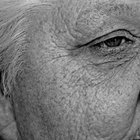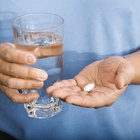
Wavebreakmedia Ltd/Lightwavemedia/Getty Images
Both collagen and melanin play a protective role in healthy skin. Melanin absorbs harmful ultraviolet light and protects the skin from photo damage. Skin collagen molecules connect to each other and form a matrix, which includes other molecules, thus creating the skin organ. It provides protection against disease and injury. The thicker the skin and the more melanin, the better the protective barrier against the effects of aging.
Melanin
Melanin is a class of biological pigments important as photo-protectors of skin. Pigment cells named melanocytes produce melanins in the outer skin layer. All melanocytes produce melanin, but cells in darker-skinned people produce more per cell. The two melanins produced by human skin include black-brown, eumelanin, and yellow-red, pheomelanin. Each melanin has separate biological properties. Also, women produce 3 to 4 percent less melanin in their skin than men.
Melanin Function
Before global migration, most humans with the darkest skin lived closest to the equator. Melanin absorbs ultraviolet light, thus protecting humans from harmful UV radiation. UV radiation damages skin cells and promotes melanoma, cancer of the skin. European Americans have a 10 times higher risk of melanoma than African Americans. Even though melanin is protective, complete shielding would be harmful, because shortwave UV radiation needs to penetrate the skin to produce vitamin D. Approximately 90 percent of vitamin D is synthesized in the skin.
Collagen
About one quarter of the human body is collagen. Collagen composes the majority of proteins in tendons, ligaments, cartilage, bone and skin. In skin it is present in the dermis, the inner layer of skin. Collagen fibers support the skin’s mechanical strength and texture. Because it has a mechanical function, collagen is subject to wear and tear. The quantity and quality of skin collagen plays a major role in appearance.
Collagen Damage
Numerous factors cause collagen damage. Some damaging factors include: sun, smoking, pollution and injury. These destroy cells and collagen molecules. Thus, injured skin cells fail to synthesize new collagen molecules to replace damaged collagen fibers. Additionally, genetics play a role in collagen destruction. It influences chronological aging, hormone depletion and immune suppression, all affecting collagen formation. In such instances, the ratio of collagen formation to collagen breakdown is reversed, and collagen is broken down faster than it can be made.
Considerations
Because both melanin and collagen protect skin from damage, supporting their function is imperative. Sufficient amounts of vitamin C promote efficient collagen synthesis, so it is a key ingredient for skin. Low-dose estrogen prevents thinning skin in post-menopausal women, and sun blocking products inhibit UV exposure beyond melanin’s protective ability. Also, dietary intake of carotenoids from fruits and vegetables protects skin from the sun’s damaging rays.
Related Articles

What Is Palmitoyl Oligopeptide?

Can I Mix Vitamin C and Copper Peptides?

Difference Between Women's Rogaine & ...

What Vitamins Help the Liver?

Facts on Natural Hair Changing Color

What Is PABA in Sunscreen?

L-Arginine & the Skin

What Foods Provide Calcium D-Glucarate?

Active Ingredients in Face Creams

Collagen & Rosacea

Beans Vs. Lentils

Zinc & Gray Hair

Elastin Supplements

What Is Transitional Housing?

Can Age Spots Be Reversed?

What Are the Dangers of Fraxel Repair?

Calories in Cheese Cubes

Traditional Uses of Cuscuta

List of Retinoids

Chemicals That Stop Testosterone ...
References
Writer Bio
Based in Michigan, Keri Gardner has been writing scientific journal articles since 1998. Her articles have appeared in such journals as "Disability and Rehabilitation" and "Journal of Orthopaedic Research." She holds a Master of Science in comparative medicine and integrative biology from Michigan State University.
Photo Credits
Wavebreakmedia Ltd/Lightwavemedia/Getty Images